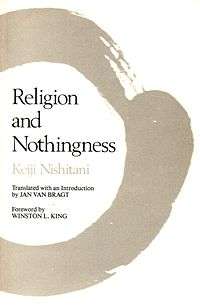Religion and Nothingness
 Cover of the English translation | |
| Author | Keiji Nishitani |
|---|---|
| Original title | Shūkyō to wa Nanika |
| Translator | Jan Van Bragt |
| Country | Japan |
| Language | Japanese |
| Subject | Nihilism |
| Published |
|
| Media type | Print (hardcover and paperback) |
| Pages | 366 (English translation) |
| ISBN | 978-0520049468 |
Religion and Nothingness (Japanese: Shūkyō to wa Nanika; the original title translates literally as "What is Religion?") is a 1961 book by the Japanese philosopher Keiji Nishitani.[1]
Summary
Nishitani relates nihilism to what he sees as the problematic nature of modern science. For Nishitani, science as understood in the age of modernity involves an objectification of both the natural world and human subject, leading to depersonalization of both. This leads to an acute sense of alienation and derootedness in human consciousness, features of the nihil that cuts through human existence. The almost worship-like attitude with which science is regarded, a corollary to atheism, further aggravates the issue.[1]
Nishitani believes that the attitude of scientism is based on the classic but faulty epistemology that separates subject and object and tends to create the illusion of the subject as an independent entity separate from the rest of the world: this creates the rift in human consciousness that lies at the root of the nihilism confronting modern humanity.[1]
Scholarly reception
Religion and Nothingness first appeared in English translation in 1982, generating increasing interest in Nishitani's ideas among philosophers, theologians, and religious scholars.[1] The book has been called Nishitani's masterwork by Graham Parkes, who writes that its philosophical synthesis matches the achievements of Søren Kierkegaard, Friedrich Nietzsche, and Martin Heidegger in depth of insight.[2]
References
Footnotes
- 1 2 3 4 Habito 1995. p. 396.
- ↑ Parkes 2005. p. 660.
Bibliography
- Books